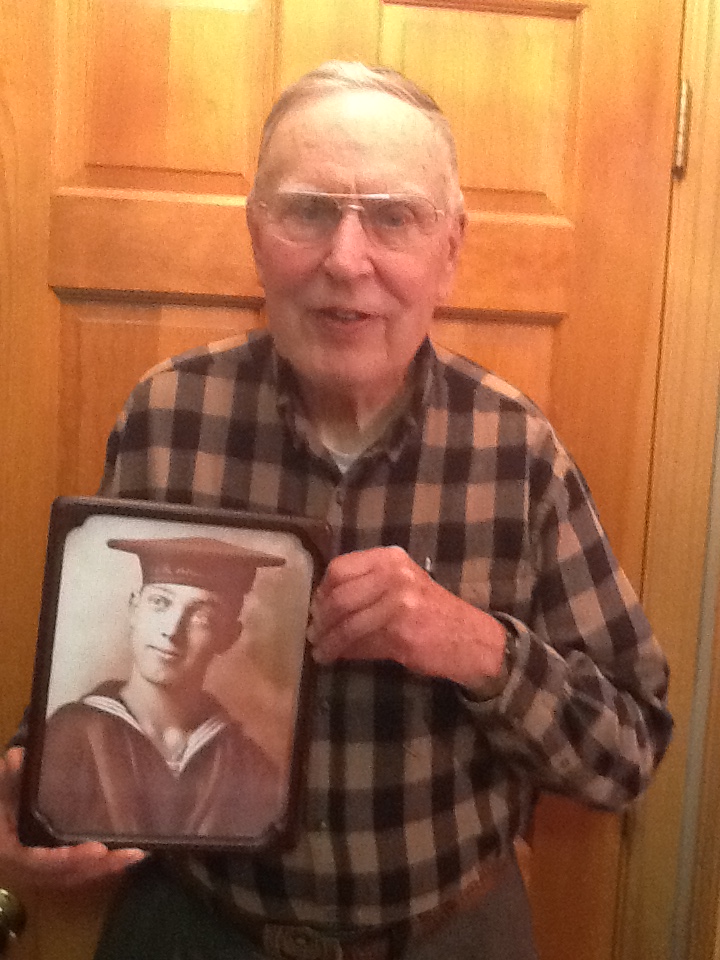
Pictured is Nichols, N.Y. resident and Korean War veteran, Norm Westervelt. Holding a framed photo of his uncle, Stanley Osborne, a U.S. Navy veteran who served on the U.S.S. Arizona from 1918-1920, Norm donated his uncle’s diary in March 2015 to a museum in Pearl Harbor. (Provided Photos)
For 60 years, Korean War veteran Norm Westervelt, of Nichols, N.Y., had safely kept a diary at his home, which was written by his uncle, Stanley Osborne, a U.S. Navy veteran who served aboard the U.S.S. Arizona from 1918-1920. Today, the diary is part of a special collection at a museum in Pearl Harbor, Hawaii.
Norm explained, “Because I showed interest in the diary, my aunt, Stanley’s widow, gave it to me.” In more recent years, Norm had a desire to find the right place to donate the diary.
Norm’s daughter Carol and her husband traveled to Hawaii in 2014 to celebrate their 40th wedding anniversary. While there, with diary in tow, Carol questioned several sources, which eventually led her to historians in Pearl Harbor. The historians were very interested in acquiring the diary then; however, Carol opted to bring it back home to discuss the options with her father.
The U.S.S. Arizona, best known in history as the battleship that sank in Pearl Harbor on Dec. 7, 1941, on the “date which will live in infamy” following a bomb attack by the Japanese, claimed more than 2,500 lives, wounded 1,000 more and damaged or destroyed 18 American ships and 300 airplanes. Nearly half of the Pearl Harbor casualties occurred on the Arizona, which was hit four times by Japanese bombers.

Pictured is Nichols, N.Y. resident and Korean War veteran, Norm Westervelt, sixth from left, and his family who traveled to Pearl Harbor, Hawaii in March 2015 to deliver the diary of Norm’s uncle, Stanley Osborne, who served on the U.S.S. Arizona from 1918-1920.
Stanley Osborne was in his mid-forties when the U.S.S. Arizona sunk, and Westervelt, then only 12-years-old, remembers his uncle’s reaction. Westervelt explained that Osborne’s connection to the vessel remained a part of his uncle’s identity and said, “He was so emotional.”
A young Osborne would have been one of the first groups of Navy personnel to serve on the Arizona. Built for and by the U.S. Navy in the mid 1910’s, the U.S.S. Arizona was commissioned in October 1916 and remained stateside during World War I. Arizona sailed for Europe in November 1918 with Osborne on board, one of a convoy of ships that escorted then President Woodrow Wilson to the Paris Peace Conference.
Osborne wrote in his diary, “Manned the rail and gave the President three cheers when he passed.”
Osborne was aboard the Arizona in 1919 during the Greco-Turkish war as well as witnessed airplanes that left the ship’s platform for first-time flying attempts, historical events that interested Pearl Harbor officials.
Busy sailing to Guantanamo Bay, Spain and Panama, among other places, Osborne’s diary reflects his interest in travel. Osborne wrote, “South of the Straits of Gibraltar; could see Africa a few miles away. It surely was wonderful scenery.”
Highlighting daily routines on ship, Osborne wrote entries about famous actress of-the-day Lillian Gish, live boxing matches and crew-boat races, and even jotted down every food item served from a Thanksgiving menu.
Considered a rare diary, Westervelt was approached by the Smithsonian to purchase it, however decided it belonged in Pearl Harbor.
In March 2015, Norm and nine of his family members flew to Hawaii, visited the memorial and other notable sites, and delivered the diary on what happened to be the Arizona’s 101st anniversary of its keel laying.
At the Courts of the Missing at the Honolulu Memorial, a cenotaph which memorializes individuals missing in action, or lost or buried at sea in the Pacific during WWII, the Korean War and Vietnam War, Westervelt found the name of a friend, Towanda, Pa. native Pete McLinko, taken Prisoner of War while fighting the enemy in South Korea in May 1951 and died while a prisoner in July that same year. His remains were not recovered.
Scott Pawlowski, Chief of Cultural and Natural Resources at the WWII Valor in the Pacific National Monument in Honolulu, Hawaii shared by phone that 99 percent of their collection is from donations, such as the diary donated by Westervelt.
“We are hugely appreciative of Mr. Westervelt’s donation. It is a nice addition to the collection,” Pawlowski said, and added, “We are especially interested in what life was like aboard the Arizona prior to December 7, 1941.”
For a short-term period Osborne’s diary will be available for use by researchers. In the future, the diary will become part of a “changing exhibit” at the museum for all visitors to see, and later as part of an on-line exhibit linked to the museum website.
Pawlowski explained that it is extremely important for families who have this type of material to consider donating it, “So we don’t lose the history.”


